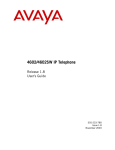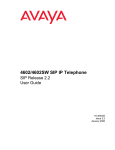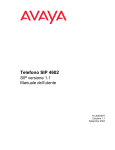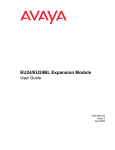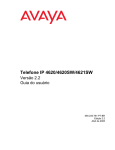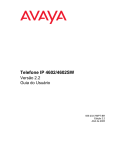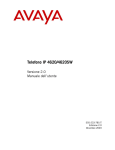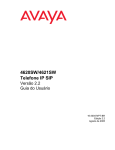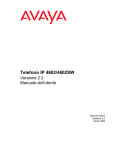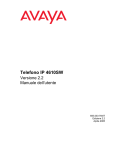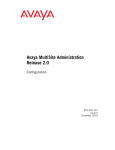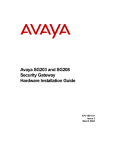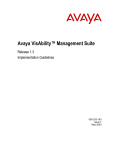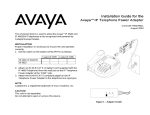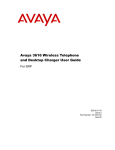Download 4602 SIP Telephone SIP Release 1.1 User's Guide
Transcript
4602 SIP Telephone SIP Release 1.1 User’s Guide 16-300035 Issue 1.1 September 2004 Copyright 2004, Avaya Inc. All Rights Reserved Notice Every effort was made to ensure that the information in this document was complete and accurate at the time of printing. However, information is subject to change. Warranty Avaya Inc. provides a limited warranty on this product. Refer to your sales agreement to establish the terms of the limited warranty. In addition, Avaya’s standard warranty language as well as information regarding support for this product, while under warranty, is available through the following Web site: http://www.avaya.com/support. Preventing Toll Fraud “Toll fraud” is the unauthorized use of your telecommunications system by an unauthorized party (for example, a person who is not a corporate employee, agent, subcontractor, or is not working on your company's behalf). Be aware that there may be a risk of toll fraud associated with your system and that, if toll fraud occurs, it can result in substantial additional charges for your telecommunications services. Avaya Fraud Intervention If you suspect that you are being victimized by toll fraud and you need technical assistance or support, in the United States and Canada, call the Technical Service Center's Toll Fraud Intervention Hotline at 1-800-643-2353. Disclaimer Avaya is not responsible for any modifications, additions or deletions to the original published version of this documentation unless such modifications, additions or deletions were performed by Avaya. Customer and/or End User agree to indemnify and hold harmless Avaya, Avaya's agents, servants and employees against all claims, lawsuits, demands and judgments arising out of, or in connection with, subsequent modifications, additions or deletions to this documentation to the extent made by the Customer or End User. How to Get Help For additional support telephone numbers, go to the Avaya support Web site: http://www.avaya.com/support. If you are: • Within the United States, click the Escalation Contacts link. Then click the appropriate link for the type of support you need. • Outside the United States, click the Escalation Contacts link. Then click the International Services link that includes telephone numbers for the international Centers of Excellence. Providing Telecommunications Security Telecommunications security (of voice, data, and/or video communications) is the prevention of any type of intrusion to (that is, either unauthorized or malicious access to or use of) your company's telecommunications equipment by some party. Your company's “telecommunications equipment” includes both this Avaya product and any other voice/data/video equipment that could be accessed via this Avaya product (that is, “networked equipment”). An “outside party” is anyone who is not a corporate employee, agent, subcontractor, or is not working on your company's behalf. Whereas, a “malicious party” is anyone (including someone who may be otherwise authorized) who accesses your telecommunications equipment with either malicious or mischievous intent. Such intrusions may be either to/through synchronous (time-multiplexed and/or circuit-based) or asynchronous (character-, message-, or packet-based) equipment or interfaces for reasons of: • Utilization (of capabilities special to the accessed equipment) • Theft (such as, of intellectual property, financial assets, or toll facility access) • Eavesdropping (privacy invasions to humans) • Mischief (troubling, but apparently innocuous, tampering) • Harm (such as harmful tampering, data loss or alteration, regardless of motive or intent) Be aware that there may be a risk of unauthorized intrusions associated with your system and/or its networked equipment. Also realize that, if such an intrusion should occur, it could result in a variety of losses to your company (including but not limited to, human/data privacy, intellectual property, material assets, financial resources, labor costs, and/or legal costs). Responsibility for Your Company’s Telecommunications Security The final responsibility for securing both this system and its networked equipment rests with you - Avaya’s customer system administrator, your telecommunications peers, and your managers. Base the fulfillment of your responsibility on acquired knowledge and resources from a variety of sources including but not limited to: • Installation documents • System administration documents • Security documents • Hardware-/software-based security tools • Shared information between you and your peers • Telecommunications security experts To prevent intrusions to your telecommunications equipment, you and your peers should carefully program and configure: • Your Avaya-provided telecommunications systems and their interfaces • Your Avaya-provided software applications, as well as their underlying hardware/software platforms and interfaces • Any other equipment networked to your Avaya products TCP/IP Facilities Customers may experience differences in product performance, reliability and security depending upon network configurations/design and topologies, even when the product performs as warranted. Standards Compliance Avaya Inc. is not responsible for any radio or television interference caused by unauthorized modifications of this equipment or the substitution or attachment of connecting cables and equipment other than those specified by Avaya Inc. The correction of interference caused by such unauthorized modifications, substitution or attachment will be the responsibility of the user. Pursuant to Part 15 of the Federal Communications Commission (FCC) Rules, the user is cautioned that changes or modifications not expressly approved by Avaya Inc. could void the user’s authority to operate this equipment. Product Safety Standards This product complies with and conforms to the following international Product Safety standards as applicable: Safety of Information Technology Equipment, IEC 60950, 3rd Edition, or IEC 60950-1, 1st Edition, including all relevant national deviations as listed in Compliance with IEC for Electrical Equipment (IECEE) CB-96A. Safety of Information Technology Equipment, CAN/CSA-C22.2 No. 60950-00 / UL 60950, 3rd Edition, or CAN/CSA-C22.2 No. 60950-1-03 / UL 60950-1. Safety Requirements for Customer Equipment, ACA Technical Standard (TS) 001 - 1997. One or more of the following Mexican national standards, as applicable: NOM 001 SCFI 1993, NOM SCFI 016 1993, NOM 019 SCFI 1998. Electromagnetic Compatibility (EMC) Standards This product complies with and conforms to the following international EMC standards and all relevant national deviations: Limits and Methods of Measurement of Radio Interference of Information Technology Equipment, CISPR 22:1997 and EN55022:1998. Information Technology Equipment – Immunity Characteristics – Limits and Methods of Measurement, CISPR 24:1997 and EN55024:1998, including: • Electrostatic Discharge (ESD) IEC 61000-4-2 • Radiated Immunity IEC 61000-4-3 • Electrical Fast Transient IEC 61000-4-4 • Lightning Effects IEC 61000-4-5 • Conducted Immunity IEC 61000-4-6 Federal Communications Commission Statement Part 15: Note: This equipment has been tested and found to comply with the limits for a Class B digital device, pursuant to Part 15 of the FCC Rules. These limits are designed to provide reasonable protection against harmful interference when the equipment is operated in a commercial environment. This equipment generates, uses, and can radiate radio frequency energy and, if not installed and used in accordance with the instruction manual, may cause harmful interference to radio communications. Operation of this equipment in a residential area is likely to cause harmful interference in which case the user will be required to correct the interference at his own expense. Part 68: Answer-Supervision Signaling Allowing this equipment to be operated in a manner that does not provide proper answer-supervision signaling is in violation of Part 68 rules. This equipment returns answer-supervision signals to the public switched network when: • answered by the called station, • answered by the attendant, or • routed to a recorded announcement that can be administered by the customer premises equipment (CPE) user. This equipment returns answer-supervision signals on all direct inward dialed (DID) calls forwarded back to the public switched telephone network. Permissible exceptions are: • A call is unanswered. • A busy tone is received. • A reorder tone is received. Avaya attests that this registered equipment is capable of providing users access to interstate providers of operator services through the use of access codes. Modification of this equipment by call aggregators to block access dialing codes is a violation of the Telephone Operator Consumers Act of 1990. Means of Connection Connection of this equipment to the telephone network is shown in the following tables. Canadian Department of Communications (DOC) Interference Information This Class B digital apparatus complies with Canadian ICES-003. Cet appareil numérique de la classe B est conforme à la norme NMB-003 du Canada. This equipment meets the applicable Industry Canada Terminal Equipment Technical Specifications. This is confirmed by the registration number. The abbreviation, IC, before the registration number signifies that registration was performed based on a Declaration of Conformity indicating that Industry Canada technical specifications were met. It does not imply that Industry Canada approved the equipment. Declarations of Conformity United States FCC Part 68 Supplier’s Declaration of Conformity (SDoC) Avaya Inc. in the United States of America hereby certifies that the equipment described in this document and bearing a TIA TSB-168 label identification number complies with the FCC’s Rules and Regulations 47 CFR Part 68, and the Administrative Council on Terminal Attachments (ACTA) adopted technical criteria. Avaya further asserts that Avaya handset-equipped terminal equipment described in this document complies with Paragraph 68.316 of the FCC Rules and Regulations defining Hearing Aid Compatibility and is deemed compatible with hearing aids. Copies of SDoCs signed by the Responsible Party in the U. S. can be obtained by contacting your local sales representative and are available on the following Web site: http://www.avaya.com/support. All Avaya media servers and media gateways are compliant with FCC Part 68, but many have been registered with the FCC before the SDoC process was available. A list of all Avaya registered products may be found at: http://www.part68.org by conducting a search using “Avaya” as manufacturer. European Union Declarations of Conformity Avaya Inc. declares that the equipment specified in this document bearing the “CE” (Conformité Europeénne) mark conforms to the European Union Radio and Telecommunications Terminal Equipment Directive (1999/5/EC), including the Electromagnetic Compatibility Directive (89/336/EEC) and Low Voltage Directive (73/23/EEC). This equipment has been certified to meet CTR3 Basic Rate Interface (BRI) and CTR4 Primary Rate Interface (PRI) and subsets thereof in CTR12 and CTR13, as applicable. Copies of these Declarations of Conformity (DoCs) can be obtained by contacting your local sales representative and are available on the following Web site: http://www.avaya.com/support. Japan This is a Class B product based on the standard of the Voluntary Control Council for Interference by Information Technology Equipment (VCCI). If this equipment is used in a domestic environment, radio disturbance may occur, in which case, the user may be required to take corrective actions. To order copies of this and other documents: Call: Avaya Publications Center Voice 1.800.457.1235 or 1.207.866.6701 FAX 1.800.457.1764 or 1.207.626.7269 Write: Globalware Solutions 200 Ward Hill Avenue Haverhill, MA 01835 USA Attention: Avaya Account Management E-mail: [email protected] For the most current versions of documentation, go to the Avaya support Web site: http://www.avaya.com/support. Contents About This Guide . . . . . . . . . . . . . . . . . . . . . . . . . . . . . . 7 Overview . . . . . . . . . . . . . . . . . . . . . . . . . . . . . . . . . . . . . . . . 7 Intended Audience. . . . . . . . . . . . . . . . . . . . . . . . . . . . . . . . . . . 7 Issue Date . . . . . . . . . . . . . . . . . . . . . . . . . . . . . . . . . . . . . . . 8 How to Use This Document . . . . . . . . . . . . . . . . . . . . . . . . . . . . . . 8 Document Organization . . . . . . . . . . . . . . . . . . . . . . . . . . . . . . . . 8 Conventions Used in This Document . . . . . . . . . . . . . . . . . . . . . . . . Symbolic Conventions . . . . . . . . . . . . . . . . . . . . . . . . . . . . . . Typographic Conventions. . . . . . . . . . . . . . . . . . . . . . . . . . . . . 9 9 9 Related Documentation . . . . . . . . . . . . . . . . . . . . . . . . . . . . . . . . 9 Chapter 1: Introducing Your 4602 SIP Telephone . . . . . . . . . . . . . 11 Introduction . . . . . . . . . . . . . . . . . . . . . . . . . . . . . . . . . . . . . . 11 The 4602 SIP Telephone . . . . . . . . . . . . . . . . . . . . . . . . . . . . . . . . 11 Chapter 2: Using Your 4602 SIP Telephone . . . . . . . . . . . . . . . . 17 Introduction . . . . . . . . . . . . . . . . . . . . . . . . . . . . . . . . . . . . . . 17 Making Calls . . . . . . . . . . . . . . Redialing the Last Number Called Speed Dialing . . . . . . . . . . . Making a Call from a Call Log . . . . . . . 17 17 18 19 Receiving Calls . . . . . . . . . . . . . . . . . . . . . . . . . . . . . . . . . . . . 19 Call Handling Features Conference . . . . . Hold . . . . . . . . . Mute. . . . . . . . . Speakerphone . . . Transfer. . . . . . . . . . . . . 20 20 21 21 21 22 Retrieving a Voice Mail Message . . . . . . . . . . . . . . . . . . . . . . . . . . . 23 Logging On and Off the Phone . . . . . . . . . . . . . . . . . . . . . . . . . . . . Logging the Phone On . . . . . . . . . . . . . . . . . . . . . . . . . . . . . . Logging the Phone Off . . . . . . . . . . . . . . . . . . . . . . . . . . . . . . 23 23 24 . . . . . . . . . . . . . . . . . . . . . . . . . . . . . . . . . . . . . . . . . . . . . . . . . . . . . . . . . . . . . . . . . . . . . . . . . . . . . . . . . . . . . . . . . . . . . . . . . . . . . . . . . . . . . . . . . . . . . . . . . . . . . . . . . . . . . . . . . . . . . . . . . . . . . . . . . . . . . . . . . . . . . . . . . . . . . . . . . . . . . . . . . . . . . . . . . . . . . . . . . . . . . . . . . . . . . . . . . . . . . . . . . . . . . . . . . . . . . . . . . . . . . . . . . . . . . . . . . . . . . . . . . . . . . . . . . . . . . . Issue 1.1 September 2004 5 Contents Chapter 3: Using Your Telephone’s Web Interface . . . . . . . . . . . . 25 Introduction . . . . . . . . . . . . . . . . . . . . . . . . . . . . . . . . . . . . . . 25 Accessing the Telephone’s Web Interface . Accessing the Web Interface . . . . . . Bypassing an Internet Proxy . . . . . . Determining the IP Address . . . . . . . Changing Your Web Access Password . . . . . . . . . . . . . . . . . . . . . . . . . . . . . . . . . . . . . . . . . . . . . . . . . . . . . . . . . . . . . . . . . . . . . . . . . . . . . . . . . . . . . . . . . . . . . . . . . . . . . . . . . 25 25 26 27 27 Web Interface Features and Operations Registering Your Telephone . . . . Restarting Your Telephone . . . . . Personalizing Your Telephone . . . Creating Speed Dial Entries . . . . . Viewing Your Call Logs . . . . . . . . . . . . . . . . . . . . . . . . . . . . . . . . . . . . . . . . . . . . . . . . . . . . . . . . . . . . . . . . . . . . . . . . . . . . . . . . . . . . . . . . . . . . . . . . . . . . . . . . . . . . . . . . . . . . . . . . . . . . . . . . . . . . . 28 28 28 29 31 32 Chapter 4: Headsets and Handsets . . . . . . . . . . . . . . . . . . . . 33 Introduction . . . . . . . . . . . . . . . . . . . . . . . . . . . . . . . . . . . . . . 33 Headsets for SIP Telephones . . . . . . . . . . . . . . . . . . . . . . . . . . . . . 33 Handsets for SIP Telephones . . . . . . . . . . . . . . . . . . . . . . . . . . . . . 34 Chapter 5: Troubleshooting. . . . . . . . . . . . . . . . . . . . . . . . . 35 Introduction . . . . . . . . . . . . . . . . . . . . . . . . . . . . . . . . . . . . . . Basic Troubleshooting Chart . . . . . . . . . . . . . . . . . . . . . . . . . . . 35 35 Index . . . . . . . . . . . . . . . . . . . . . . . . . . . . . . . . . . . . . . . . . . . . . . 6 4602 SIP Telephone SIP Release 1.1 User’s Guide 37 About This Guide Overview This guide covers how to use your new 4602/4602SW SIP Telephone. The 4602/4602SW is simple to use while offering the latest advances in telephony systems. Updates and new features are downloaded to your phone without the need for phone replacement. Although the 4602/4602SW is a basic SIP telephone model, it shares many characteristics with higher-end telephones, including ease of operation for its users. This guide contains five chapters, geared to how you actually use the phone. It covers: ● the buttons and features on the phone itself, ● making and receiving calls, ● getting your voice mail messages, ● using the Web interface to access features like speed dial setup and call logs, ● a list of compatible headsets and handsets, and ● troubleshooting you can perform to ensure that your 4602/4602SW SIP Telephone is operating properly. The 4602 and 4602SW are identical phones from the point of view of user interface, capabilities, administration, etc. The only difference is that the 4602SW has a second Ethernet port and an internal switch for connecting a PC to the LAN. Any reference in this guide to the 4602 SIP Telephone applies equally to the 4602SW SIP Telephone. Intended Audience This document is intended for telephone users who have a 4602/4602SW SIP Telephone at their desks. It is not intended to be a technical reference guide for System Administrators or phone technicians. Issue 1.1 September 2004 7 About This Guide Issue Date This document was issued for the first time in June, 2004. It was revised for Release 1.1 in September, 2004. Release 1.1 provides speed dialing using the telephone keypad and the addition of time and date to Call Log entries. How to Use This Document This Guide is organized to help you find topics in a logical manner. Read it from start to finish to get a complete understanding of how to use your 4602/4602SW SIP Telephone. You can also review the Table of Contents or Index to locate information specific to a task or function you want to perform. Document Organization This guide contains the following chapters: Chapter 1: Introducing Your 4602 SIP Telephone Describes each button and feature on the face of the telephone. Chapter 2: Using Your 4602 SIP Telephone Covers all call-related information, such as making calls, conferencing, and transferring calls. This chapter also covers accessing voice mail messages, and logging the phone on or off. Chapter 3: Using Your Telephone’s Web Interface Covers how to use the telephone’s Web interface to access additional features. Chapter 4: Headsets and Handsets Provides information about SIP-compatible handsets and headsets. Chapter 5: Troubleshooting Provides basic troubleshooting actions, if you encounter errors or experience problems. 8 4602 SIP Telephone SIP Release 1.1 User’s Guide Conventions Used in This Document Conventions Used in This Document This guide uses the following textual, symbolic, and typographic conventions to help you interpret information. Symbolic Conventions Note: Note: This symbol precedes additional information about a topic. Typographic Conventions This guide uses the following typographic conventions: message Words printed in this type are system messages. Document Blue underlined type indicates a section or sub-section in this document containing additional information about a topic. “Document” Italic type enclosed in quotes indicates a reference to an external document or a specific chapter/section of an external document. italics Italic type indicates the result of an action you take or a system response in step by step procedures. Administrative Words printed in bold type are menu or screen titles and labels. Words in this type might also be items on menus and screens that you select or enter to perform a task, i.e., fields, buttons, or icons. Related Documentation For information on administering this telephone see the “4602 SIP Telephone Administrator’s Guide” (Document Number 16-300037). Issue 1.1 September 2004 9 About This Guide 10 4602 SIP Telephone SIP Release 1.1 User’s Guide Chapter 1: Introducing Your 4602 SIP Telephone Introduction This chapter introduces you to the layout of the 4602 SIP Telephone. It provides a description for each functional button and other phone characteristics. The 4602 SIP Telephone The 4602 SIP Telephone has: ● two Line (Call Appearance) buttons, ● ten dedicated feature buttons, ● a 2-line by 24-character display area, and ● a one-way, listen-only speakerphone. Issue 1.1 September 2004 11 Introducing Your 4602 SIP Telephone Figure 1: 4602 SIP Telephone 1 3 2 4 5 6 11 7 8 12 13 9 14 10 12 4602 SIP Telephone SIP Release 1.1 User’s Guide 15 The 4602 SIP Telephone Table 1: 4602 SIP Telephone Button/Feature Descriptions 1 of 3 Callout Number Button/ Feature Name Button/Feature Description 1. Message Waiting Lamp When lit, indicates you have a message waiting on your voice messaging system. 2. Display (No Icon Shown) The display screen has two lines of 24 characters each. During phone usage, the display shows the name/phone number of the person calling you. When you place a call, the display shows the number you are calling. When idle, the time and date display on the top line, and your SIP user name or extension display on the bottom line. During transfers and conference calls helpful information appears on the display. When you adjust the handset, speaker, or ringer volume level, a graphical display of the current level is shown on the bottom line. Icons can appear on the left side of the display to indicate the current state of the Call Appearance (Line) buttons. These states are: Idle - Indicates the line is available and is not in use. Active - indicates that you are using this line. Ringing - the bell flashes to indicate an incoming call on this line. Hold - indicates a call is on hold on this line. 3. Line buttons The two Call Appearance Line buttons are dedicated to incoming and outgoing calls, and are labeled with an: a. (first Line button) and b. (second Line button). 1 of 3 Issue 1.1 September 2004 13 Introducing Your 4602 SIP Telephone Table 1: 4602 SIP Telephone Button/Feature Descriptions 2 of 3 Callout Number Button/ Feature Name 4. Speaker 5. Speaker LED Indicator 6. Voice Message Button 7. Mute 8. Mute LED Indicator 9. Volume Control 10. Numeric (Dialing) Pad 11. Hold 12. Transfer 13. Conference Button/Feature Description Accesses the listen-only, one-way Speakerphone feature. Lights steadily when the listen-only, one-way Speakerphone is active. Accesses your Voice Messaging System. Turns off the active handset microphone, to prevent the other person from hearing you. Lights steadily when the handset is muted. Adjusts the handset, speaker, or ringer volume, depending on which item is in use. Standard 12 button pad for dialing phone numbers. Red button used to place a call on hold. Transfers a call to another phone. Sets up conference calls with more than one other person. 2 of 3 14 4602 SIP Telephone SIP Release 1.1 User’s Guide The 4602 SIP Telephone Table 1: 4602 SIP Telephone Button/Feature Descriptions 3 of 3 Callout Number Button/ Feature Name 14. Drop 15. Redial Button/Feature Description Drops the last person added to a conference call. Redials the last number dialed from the phone. 3 of 3 Issue 1.1 September 2004 15 Introducing Your 4602 SIP Telephone 16 4602 SIP Telephone SIP Release 1.1 User’s Guide Chapter 2: Using Your 4602 SIP Telephone Introduction This chapter covers making calls, receiving calls, and using call handling features. You can use call handling features when making a call or while a call is in progress. Call handling features have dedicated phone buttons, such as Conference, Hold, Mute, Transfer and Speaker. This chapter also includes information on retrieving messages left in your voice mailbox. Making Calls To make a call: 1. Pick up the handset or press the Speaker button. The Handset icon appears in the display. 2. Dial your party. Connection proceeds. Note: Note: If you experience difficulty making International calls, try pressing # after entering the International telephone number. Some dial plans require this additional entry to indicate that your dialing sequence is complete. If you continue to experience difficulty calling internationally, contact your System Administrator for specific instructions. Redialing the Last Number Called The Redial feature automatically starts dialing the most recent extension or outside number dialed. Press the Redial button. The last number dialed is automatically redialed. Issue 1.1 September 2004 17 Using Your 4602 SIP Telephone Speed Dialing Use the telephone keypad or your PC and the Web interface to automatically dial frequently-called numbers. The 4602 SIP Telephone has three quick dialing methods as described below. To dial a speed dial entry using the telephone keypad You must first set up Speed Dial entries, as described in Creating Speed Dial Entries in Chapter 3: Using Your Telephone’s Web Interface. 1. Pick up the handset or press the Speaker button. The Handset icon appears in the display. 2. Press * followed by the two-character Speed Dial number assigned to the party you want to call. Connection proceeds. To dial a SIP URI from the Home page You must know the URI of the SIP Telephone user you want to call. 1. Open your Web browser to the telephone’s Web interface. Note: Note: If you do not know how to perform Step 1, first see Accessing the Web Interface on page 25. 2. On the Home page, locate the Enter SIP URI to Dial prompt. 3. Enter another SIP user’s URI in the field to the right of the prompt, and click Dial. The 4602 immediately dials the party associated with the URI entered. To dial a speed dial entry from the Home page You must first set up Speed Dial entries, as described in Creating Speed Dial Entries in Chapter 3: Using Your Telephone’s Web Interface. 1. Open your Web browser to the telephone’s Web interface. Note: Note: If you do not know how to perform Step 1, first see Accessing the Web Interface on page 25. 2. Click Speed Dialing. 18 4602 SIP Telephone SIP Release 1.1 User’s Guide Receiving Calls 3. Click Dial for the speed dial entry you want to call. The telephone’s Speakerphone automatically activates and dials the number associated with that speed dial entry. The Home page re-displays. Making a Call from a Call Log Call logs are automatically populated with missed (unanswered), incoming (answered) and outgoing calls made or received since the last telephone Restart. Use the telephone’s Web interface to view and/or to return calls listed on these logs. To call a number listed in these fields: 1. Open your Web browser to the telephone’s Web interface. Note: Note: If you do not know how to perform Step 1, first see Accessing the Web Interface on page 25. 2. From the Home page, select Call Logs. 3. On any of the Call Logs, click the Down/Up Arrow until the number, name, or SIP URI of the party you want to call displays. 4. Select the desired entry. The selected name, number, or SIP URI appears in the Dial box below that Call Log. 5. Click the Dial button. The selected number appears in a text box. 6. Edit the number if required (for example, to add a 9 at the beginning for an outside number) and click the Dial button. The 4602 immediately dials the selected party. Receiving Calls When someone calls you, a flashing Bell icon appears in the display next to one of the two Call Appearance buttons as the phone rings. To answer the call, pick up the handset and talk. The Bell icon changes to a Handset icon indicating you are active on the incoming call. Issue 1.1 September 2004 19 Using Your 4602 SIP Telephone Call Handling Features The features described in this section are available while calls are in progress. Conference The Conference feature allows you to conference up to three parties on a call, including yourself. Setting up a three-party conference call 1. Dial the first party, then press the Conference The current call is placed on hold, the Hold button. icon displays, and you hear a dial tone. 2. Dial the number of the next party and wait for an answer. 3. Press the Conference button again to add the new party to the call. All parties are now connected. Adding a held call to the current call 1. Press the Conference button. The current call is placed on hold, the Hold icon displays, and you hear a dial tone. 2. Dial the number of the next party and wait for an answer. 3. Press the Conference button again to add the new party to the call. All parties are now connected. Dropping the last person added to a conference call Press the Drop button. The last party connected to the conference call is dropped from the call. 20 4602 SIP Telephone SIP Release 1.1 User’s Guide Call Handling Features Hold The Hold feature puts a call on hold until you return to it. Placing a call on hold Press the Hold button. The icon on the current call appearance changes to the Hold icon. Returning to a held call Press the Call Appearance button of the held call. The call is retrieved. Mute During an active call, the Mute feature prevents the party with whom you are speaking from hearing you. Use this feature to hold an off-line conversation at any time during a call. Preventing the other person or people on the call from hearing you 1. Press the Mute button. The other party cannot hear you. The indicator light next to the Mute button lights when Mute is active. 2. To reinstate two-way conversation, press the Mute button again. Speakerphone A one-way Speakerphone allows you to listen to calls without lifting the handset. When you press the Speaker button, the indicator light illuminates to remind you that the listen-only Speakerphone is engaged. Note: Note: This Speakerphone is a one-way, listen-only device. The party at the other end of the call cannot hear your voice, even though you can hear theirs. Issue 1.1 September 2004 21 Using Your 4602 SIP Telephone Changing from the Speakerphone to the Handset Pick up the handset and talk. The Speaker indicator light goes off. Turning on the Speakerphone during a call Press the Speaker button. The Speaker indicator next to the Speaker button lights, the handset is disabled and the speaker is activated. You can hear the person on the other end, but they cannot hear you. Hanging up the handset does not drop the call. Turning the Speakerphone off during a call Lift the handset at any time. The speaker and the corresponding indicator light turn off. Voice communications revert to the handset. Ending a call while the speaker is active Press the Speaker button. The Speaker and the corresponding indicator turn off and the call terminates. Transfer The Transfer feature allows you to transfer a call from your telephone to another extension. Sending a call to another telephone 1. With the call active, press the Transfer The current call is placed on hold, the Hold button. icon displays, and you hear the dial tone. 2. Dial the number to which you want to transfer the call. 3. If you do not want to announce the call, press the Transfer button again. If you want to announce the call, wait for the person to answer and then press the Transfer button after announcing the call. A confirmation message, Transfer Complete appears briefly on the display. 4. Hang up your handset. 22 4602 SIP Telephone SIP Release 1.1 User’s Guide Retrieving a Voice Mail Message Retrieving a Voice Mail Message When someone leaves a message in your voice mailbox, the Message Indicator at the top middle of the phone illuminates. To retrieve your voice mail, press the Message button above the numeric dial pad. The 4602 SIP Telephone automatically dials your voice mail system. Once connected to your corporate Voice Mail, follow your standard voice mail retrieval procedures. If you have voice mail-related questions, contact your System Administrator. It is possible to disable the Voice Mail feature. If voice mail retrieval does not operate as indicated, contact your System Administrator to be sure that your telephone’s voice mail connection is enabled. Logging On and Off the Phone Your System Administrator can enable a Forced Login feature that requires you to log on to your telephone before the phone can be used. You can also log your phone off as a security precaution to prevent unauthorized use. The two procedures below apply to logging off/on using the 4602 telephone only, not the Web interface. Note: Note: Your System Administrator has provided you with two passwords. One password (SIP password) accesses the Web interface and the other password is associated with your telephone’s extension. The password referred to in the procedures below refers to your telephone extension password. Logging the Phone On When the phone is in a logged off state, the prompt “Ext=” appears on the telephone’s top display line. 1. Use the dial pad to enter your extension number. 2. Press the # (pound) button. The prompt, Password=? appears on the top line of the display. 3. Use the dial pad to enter your password. 4. Press the # (pound) button. Your phone will now register and be ready for use. Issue 1.1 September 2004 23 Using Your 4602 SIP Telephone Logging the Phone Off To Log Off the phone: 1. Press the Mute button. 2. Press the digits 5 6 4 6 3 3 # (L O G O F F #) on your dial pad. The prompt Ext= appears on the top display line, indicating the phone is in a logged off state. 24 4602 SIP Telephone SIP Release 1.1 User’s Guide Chapter 3: Using Your Telephone’s Web Interface Introduction The 4602 SIP Telephones are equipped with a Web interface that you can use to manage your phone and to personalize its operation. From this interface you can: ● Change the default password to access the Web interface to a password of your choosing. ● Enter your phone system extension and password to log in to the phone system. ● Personalize your telephone’s operation by setting the date format, ring type, and the display name that others see when you call them. ● Create a list of speed dial numbers that can be quickly dialed from the Web interface. ● Review and call back numbers in your incoming, outgoing, and missed call logs. ● Update your telephone’s software with recent upgrades. Accessing the Telephone’s Web Interface To access the Web interface, you need to know the IP (Internet Protocol) Address assigned to your phone. If you do not know the IP Address, see the procedure in this chapter titled Determining the IP Address first. Accessing the Web Interface To access the telephone’s Web interface: 1. Enter this command into the address bar of your PC’s internet browser: http://aaa.bbb.ccc.ddd/ (where aaa.bbb.ccc.ddd is the IP address assigned to your telephone) You can also just enter the IP Address without typing http:// to precede it. Note: Note: If you do not know your IP Address, see Determining the IP Address. Press Enter. A login window displays. Issue 1.1 September 2004 25 Using Your Telephone’s Web Interface Note: Your System Administrator can provide information on setting up your User Name and password, if needed. Note: 2. Choose one of the following options: Note: If Then You already have a Web interface User Name and password. Enter your password. Your password is the last four characters of your MAC address, unless you changed it. You do not have a User Name or a password. Press Mute, then enter 4 6 3 6 (I N F O). Press the # key until the phone displays a MAC Address on the top line and a number like 00-09-6E-03-85-FB on the bottom line. Leave the User Name field blank. Enter the last 4 characters of your MAC address without hyphens and in lower case as a default password. In the example shown here, you would enter 85fb. Note: To change the password you use for Web interface access, see Changing Your Web Access Password later in this chapter. Your browser displays the Web interface Home page. Note: Note: You can bookmark this page for future access, however, be aware that system updates could change your IP Address. 3. Press * on the telephone dial pad to return the phone to normal operation. Note: Note: Some networks require all browsers to use a proxy for internet access. If you have problems accessing the Web interface, it could be because of the browser’s use of a proxy. See the next procedure to bypass the proxy. Bypassing an Internet Proxy If you have problems accessing the Web interface, you may have to first bypass the proxy using Internet Explorer, as covered in the steps below: 1. Open Internet Explorer on your PC. 2. Click Tools and select Internet Options. 3. Select the Connections tab and then click the LAN Settings button. 26 4602 SIP Telephone SIP Release 1.1 User’s Guide Accessing the Telephone’s Web Interface 4. If Use a proxy server for your LAN is selected, click the Advanced button. If this option is not selected, you are not using a proxy. In this case, stop now and contact your System Administrator for further assistance. 5. In the Exceptions box enter the IP address for your phone. 6. Click OK to close all the dialog boxes. 7. Proceed as described in Accessing the Web Interface. Determining the IP Address To find out the IP address currently assigned to your telephone, follow this procedure while your phone is idle. 1. Press Mute , followed by the key sequence 4 6 3 6 # (I N F O #). The phone displays Info View *=End #=Next. 2. Press #. The phone displays IP Address (Static or DHCP)on the top line and aaa.bbb.ccc.ddd (the actual IP Address) on the bottom line. 3. Return to the Accessing the Web Interface procedure and enter the IP Address in Step 1. Changing Your Web Access Password For added telephone/web security, change the password you use to access the Web interface occasionally. 1. Access the Web interface. 2. With the Home page displayed, select User Security. The User Security page displays. 3. Enter your current Password. 4. Enter a new Password, using 6 or more characters. 5. Re-enter the new Password and click Save. The Home page re-displays. 6. Select Restart to activate the new password. The Reset Hardware page displays. 7. Click Reset. The telephone resets all settings, after which you can use your new password for web access. Issue 1.1 September 2004 27 Using Your Telephone’s Web Interface Web Interface Features and Operations Registering Your Telephone Before you can use your phone, it must be registered with the network. If you have already logged your phone on and registered, you can skip this procedure. 1. Open your Web browser to the telephone’s Web interface (see Accessing the Web Interface). 2. Enter the (SIP) User Name or Extension and password provided by your System Administrator into the appropriate Web page fields. Note: Note: See Changing Your Web Access Password if you want to establish a different Web access password for security reasons. 3. Click Save at the bottom of that page to save your changes. 4. Click Restart to restart your phone with the new registration information. 5. Click Reset. The phone performs the restart process, updating its settings and software as applicable, and registering the phone with the server. When the restart is finished, the Home page re-displays. Restarting Your Telephone Restart your telephone to make changes made to your personal settings (other than Speed Dial entries, ring type or password) effective. Restarting the phone also updates its internal software with any recent upgrades. 1. From the Home page, select Restart. The Reset Hardware page displays. 2. Click Reset. The phone performs the restart process to update its settings and software as applicable. All Call Log entries are cleared as well. When the restart is finished, the Home page re-displays. 3. Enter your password to log back in to the Web interface. 28 4602 SIP Telephone SIP Release 1.1 User’s Guide Web Interface Features and Operations Personalizing Your Telephone Changing your Ring Tone To change your ringer type follow these steps: 1. Access the Web interface and select Personal Setting from the Home page menu. The Personal Setting page displays. 2. From the Ring Type drop down list, choose one of the 14 tones by selecting Ringer 1 through Ringer 14. 3. Click Save at the bottom of that page to save your changes. Note: Note: There is no facility to scroll through the ringer tones. After selecting and saving a new setting press the Up/Down Volume button to listen to the ring tone you selected. Repeat this procedure to change the current tone. Changing your Display Name To change the name that others see when you call them, follow these steps: 1. Access the Web interface and select Personal Setting from the Home page menu. The Personal Setting page displays. 2. In the Display Name field, enter the display name you want shown as your Caller ID. 3. Click Save at the bottom of that page to save your change. 4. When the Home page re-displays, click Restart to activate the new Display Name. Changing the Date and Time display format To change the way the date and time display on your phone, follow these steps: 1. Access the Web interface and select Personal Setting from the Home page menu. The Personal Setting page displays. 2. From the Date-Time Format drop down list, choose one of the date formats. 3. Click Save at the bottom of that page to save your changes. 4. When the Home page re-displays, click Restart to activate the new format. Issue 1.1 September 2004 29 Using Your Telephone’s Web Interface Changing your User Name (Extension) Your User Name (Extension) and password allow you to log your phone into the telephone system. Note: Note: Avaya recommends that the User Name (Extension) not be changed. Change your User Name, Extension Number, or password only with your System Administrator’s authorization and approval. 1. Access the Web interface and select Personal Setting from the Home page menu. The Personal Setting page displays. 2. In the User Name field, enter the name or Extension you will use for telephone login. 3. Click Save at the bottom of that page to save your entry. Changing your Password (Extension) This password, in conjunction with your User Name, allows you to log your phone into the telephone network. This password authenticates the extension or User Name covered in the Changing your User Name (Extension) procedure. Note: Note: Avaya recommends that the Password (Extension) not be changed. Change your User Name, Extension Number, or password only with your System Administrator’s authorization and approval. 1. Access the Web interface and select Personal Setting from the Home page menu. The Personal Setting page displays. 2. In the Password field, enter the password you want to use. 3. Click Save at the bottom of that page to save your password. 30 4602 SIP Telephone SIP Release 1.1 User’s Guide Web Interface Features and Operations Creating Speed Dial Entries You can use the Web interface to define up to 25 phone numbers or SIP URIs. You can then “speed dial” these numbers with a mouse click, as covered in Speed Dialing in Chapter 2: Using Your 4602 SIP Telephone. Creating a speed dial entry To create one or more new speed dial numbers, follow these steps: 1. Access the Web interface. 2. From the Home page, click Configure Speed Dial. 3. Choose an unused row to enter a new speed dial number. Note that the left-most column shows the dial pad sequence (an asterisk followed by two digits) to use to dial this entry. Note: Note: You can also update an existing entry by selecting it and making the desired modifications, then clicking on Save at the bottom of the screen. To delete an entry, highlight it and press your keyboard’s Delete key. 4. Enter an alphanumeric name in the space provided. 5. Enter the phone number or SIP Address you want to assign to this speed dial number. 6. Repeat steps 3 through 5 for each new speed dial entry. 7. Click Save at the bottom of that page to save your changes. Issue 1.1 September 2004 31 Using Your Telephone’s Web Interface Viewing Your Call Logs The 4602 SIP Telephone maintains three logs with up to 20 entries per log. They are: ● Incoming (answered) calls ● Missed (unanswered) calls ● Outgoing Calls Use the Web interface to view your Call Logs and dial a listed party. Note: Note: Note: When a Call Log has 20 entries, a new entry causes the oldest entry to drop off the log. Note: Resetting your telephone (by pressing Restart) clears all Call Logs. 1. Access the Web interface and select Call Logs from the Home page menu. The Call Logs page displays all three logs, showing the number/ID and the date and time of each call. A Dial box displays below each log. 2. Use the Up/Down Scroll Arrows to view any information exceeding the current page length. 3. To dial a party, highlight (select) the desired entry to display it in the Dial Missed Calls box, then click Dial. 4. To return to the Home page, click Home at the top of the Call Logs page. 32 4602 SIP Telephone SIP Release 1.1 User’s Guide Chapter 4: Headsets and Handsets Introduction This chapter provides information about headsets and specialized handsets that are compatible with your SIP telephone. Headsets for SIP Telephones Avaya supports only those headsets and headset adapters that carry an Avaya brand or logo. There are a variety of Avaya headsets that are compatible with your SIP Telephone. Note: The 4602 SIP Telephone does not have a separate headset jack. Any plug-in headset uses the handset jack, and the handset is only used for switch-hook control. Note: To see the available headsets, view the “Freedom of Choice Headsets” brochure. To access the “Freedom of Choice Headsets” brochure: 1. Go to http://www.avaya.com 2. Mouse over Products & Services and select Products A-Z. 3. Select Headsets. 4. Under Find out More…, select Brochures, then Freedom of Choice Headsets. Headsets require headset adapters/connectors to operate. Avaya offers three types of headset adapters for SIP Terminals: ● The MIP-1, which provides remote call answering and call initialization features with the Avaya Cordless Headset. ● The Modular base amplifier (M12LUCM), which is a high-performance solution for users who continuously wear headsets, and ● The HIP cord, which allows basic, direct headset connection to your Avaya IP telephone. Avaya also offers a cordless headset solution (LKA10) with up to a 150 ft. mobile range from the base. The LKA10, when used with the MIP-1, offers remote call answering and call initialization features on the 4610SW, 4620, 4620SW and 4630SW IP Telephones. The MIP-1 must be ordered separately. The LKA10, when used without the MIP-1, operates with other Avaya IP and SIP telephones, but cannot be used for remote call answering or call initialization. Issue 1.1 September 2004 33 Headsets and Handsets The table below summarizes Avaya’s corded headset connectors and cordless headset choices, and provides ordering codes. Headset Connector Type Ordering Code M12LUCM Corded 407639715 HIP Cord Corded 700212442 LKA10 (includes Headset) MIP-1 Cordless Solution Accessory 408271385 700281074 Handsets for SIP Telephones Specialized handsets are available for noisy environments, hearing-impaired users, and other special purposes. See the following table for specialized handsets, and replacement handsets for your phone. Handset Connector Type Ordering Code AK1A-2001 Replacement Handset 700203797 AK5A-1001 Push-to-Talk 700229727 AK6A-1001 Amplified 700229735 AK8A-1001 Noisy Location 700229743 34 4602 SIP Telephone SIP Release 1.1 User’s Guide Chapter 5: Troubleshooting Introduction This section describes some simple troubleshooting procedures. If you experience a problem that is not covered here, contact your System Administrator. Basic Troubleshooting Chart Problem/Symptom Suggested Solution Phone does not activate when it is plugged in and nothing appears on the display. The set may not be receiving power. Ensure that the Ethernet cable is plugged into the jack labeled and that the power source is plugged into a working outlet. Phone has information on the display, but does not respond to button pushes. Try restarting the phone by unplugging the Ethernet cable plugged into the jack labeled and re-plugging the cable. Display shows an error or informational message. Write down the message or messages that appear and contact your System Administrator. Audio quality is poor on both the handset and speaker. You might hear clipped, garbled, or severely delayed speech. Various potential network problems might be causing this problem. Provide your System Administrator with information about when this happened and how long it lasted. The phone’s display shows Registration Failed. You might be entering an incorrect login name or password. Verify the proper login and password you can use with your System Administrator. No audio from the handset, but the speaker works properly. Double-check that the handset is properly plugged into the phone. Try swapping a handset from a similar phone to determine if the handset or cord is defective. Issue 1.1 September 2004 35 Troubleshooting Problem/Symptom (continued) Suggested Solution (continued) The Web interface does not work, or works intermittently. Your company could be using a proxy server. To bypass the proxy when accessing your phone, follow the Bypassing an Internet Proxy procedure. Your phone’s IP address might also have changed since you last accessed the Web interface. See Determining the IP Address to ensure you are using the proper URL address to connect to the phone. Speed dialing using the telephone keypad does not work. Your System Administrator may have inadvertently activated a feature which overrides the ability to speed dial. Contact your System Administrator for a resolution. All other problems. Contact your System Administrator. 36 4602 SIP Telephone SIP Release 1.1 User’s Guide Index Index Numerical F 4602 . . . . . . . . . . . . . . . . . . . . 11, 12, 13 4602 SIP Telephone Using the phone . . . . . . . . . . . . . . . . 17 Feature/Button Descriptions . . . . . . . . . . . . . 13 A Handsets and Headsets. . . . . . . Handsets for SIP Telephones . . . . Headsets for SIP Telephones . . . . Held call, adding to a conference call Hold button. . . . . . . . . . . . . Hold feature . . . . . . . . . . . . How to Use This Document . . . . . About This Guide . . . . . . . . . . . . . . . . . . 7 Adding a held call to the current call, when conferencing20 B Button/Feature Descriptions . . . . . . . . . . . . 13 Bypassing an Internet Proxy . . . . . . . . . . . . 26 C Call Handling Features . . . . . . . . . . . Call Log, Making a Call from . . . . . . . . Call Logs, Viewing and Dialing from . . . . . Calls Making . . . . . . . . . . . . . . . . . Receiving . . . . . . . . . . . . . . . Redialing the last number called . . . . . Changing your Password (Extension) . . . . Changing your User Name (Extension) . . . Conference Dropping the last person added to the call Conference button . . . . . . . . . . . . . Conference feature . . . . . . . . . . . . Conference, setting up a three-party call. . . Conventions Used in This Document . . . . . . . . 20 . . . . 19 . . . . 32 . . . . . . . . . . . . . . . . . . . . 17 19 17 30 30 . . . . . . . . . . . . . . . . . . . . 20 14 20 20 . 9 Date and Time display format, changing the . . . . . Dialing a SIP URI from the Web interface . . . . . . Dialing a speed dial entry from the Home page . . . Dialing a speed dial entry using the telephone keypad Display area, description of . . . . . . . . . . . . . Display Name, changing the . . . . . . . . . . . . Document Organization . . . . . . . . . . . . . . Document, How to Use . . . . . . . . . . . . . . . Documentation, Related . . . . . . . . . . . . . . Drop button . . . . . . . . . . . . . . . . . . . . Dropping the last person added to a Conference Call. 29 18 18 18 13 29 . 8 . 8 . 9 15 20 H . . . . . . . . . . . . . . . . . . . . . . . . . . . . . . . . . . . . . . . . . . . . . . . . . . . . . . . . 33 34 33 20 14 21 .8 . . . . . . . . . . . . . . . . . . . . . . . . . . . . . . . . . . . . . . . . . . . . . . . . .7 .7 I Intended Audience . . . . . . . Intended Audience, for this guide Internet Proxy, Bypassing a . . . Introducing . . . . . . . . . . . IP Address, Determining the . . . Issue Date, of this document . . . . . . . . . . . . . . 26 11 27 .8 L Line buttons . . . . . . . . . . . . . . . . . . . . 13 Logging the Phone On and Off . . . . . . . . . . . 23 M Making Calls . . . . . . Message Waiting Lamp . Mute button . . . . . . Mute LED Indicator . . . . . . . . . . . . . . . . . . . . . . . . . . . . . . . . . . . . . . . . . . . . . . . . . . . . . . . . . . . 17 13 14 14 D P Password, Web Access . . . . . . . . . . . . . . . 27 Personalizing Your Telephone . . . . . . . . . . . . 29 R Receiving Calls . . . . . . . . . . . . . . . Redial button . . . . . . . . . . . . . . . . Redialing . . . . . . . . . . . . . . . . . . Registering your Telephone, for Web interface Related Documentation . . . . . . . . . . . . . . . . . . . . . . . . . . . . . . . Issue 1.1 September 2004 19 15 17 28 .9 37 Index Restarting Your Telephone . . . . . . . . . . . . . 28 Retrieving a Voice Mail Message . . . . . . . . . . 23 Ringer, changing the tone . . . . . . . . . . . . . 29 S Security . . . . . . . . . . . . . . . . . . . . Setting up a three-party conference call . . . . . SIP URI, dialing a party using . . . . . . . . . . Speaker . . . . . . . . . . . . . . . . . . . . Speaker LED Indicator . . . . . . . . . . . . . Speakerphone Changing to the Handset . . . . . . . . . . Ending a call while active . . . . . . . . . . Turning off during a call . . . . . . . . . . . Turning on during a call . . . . . . . . . . . Speakerphone feature . . . . . . . . . . . . . Speed Dial Entries, Creating . . . . . . . . . . Speed Dialing . . . . . . . . . . . . . . . . . Speed dialing dialing a speed dial entry from the Home page dialing a URI from the Home page . . . . . . using telephone keypad . . . . . . . . . . . . . . . . . . . . . 27 20 18 14 14 . . . . . . . . . . . . . . 22 22 22 22 21 31 18 . . 18 . . 18 . . 18 T The . . . . . . . . . . . . . . . . . . . . . . . . .11 Transfer feature . . . . . . . . . . . . . . . . . . 22 Troubleshooting Chart, Basic . . . . . . . . . . . . 35 38 4602 SIP Telephone SIP Release 1.1 User’s Guide U User Name (Extension) . . . . . . . . . . User Name/Extension password, changing . Using the 4602 SIP Telephone . . . . . . Using Your Telephone’s Web Interface . . . . . . . . . . . . . . . . . . . . . . 30 30 17 25 . . . . . . . . . . . . . . . . . . . . 32 23 14 14 V Viewing Your Call Logs . . . . Voice Mail Message, retrieving Voice Message Button . . . . Volume Control button . . . . . . . . . . . . . . . . . . . . . . . . . . . . W Web Access Password, Changing . . . . . . . . . Web Interface Accessing the . . . . . . . . . . . . . . . . . Changing your User Name/Extension Password . Features and Operations. . . . . . . . . . . . Personalizing Your Telephone . . . . . . . . . Registering Your Telephone . . . . . . . . . . Restarting phone using . . . . . . . . . . . . User Name (Extension) . . . . . . . . . . . . Web Interface, Using the . . . . . . . . . . . . . . 27 . . . . . . . . 25 30 28 29 28 28 30 25






































